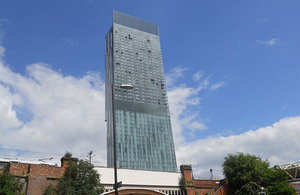Northern Powerhouse: Chancellor sets out pathway
The government鈥檚 pathway to a northern economic powerhouse is set out by the Chancellor in a speech at Beetham Tower, Manchester.

The Chancellor of the Exchequer, George Osborne today (Tuesday 5 August) set out the government鈥檚 pathway to a northern economic powerhouse when he welcomed the publication of a report on the future of the northern economy by the city regions of Leeds, Liverpool, Manchester, Newcastle and Sheffield.
The report 鈥� 鈥� sets out a vision for the economy of the North of England for the next 15 years.
The report鈥檚 launch comes six weeks after the Chancellor set out his vision of connecting the great cities of the north to become one Northern Powerhouse.
The report was launched at an event at Beetham Tower in Manchester.
The Chancellor warmly welcomed the and the consensus that is emerging on what needs to be done to build the Northern Powerhouse. He used his speech to set out a pathway to that powerhouse, saying:
Today I give you this personal commitment.
Work with me over the coming months and together we will make a reality of the plan I鈥檝e set out for the Northern Powerhouse.
I鈥檓 ready to commit new money, new infrastructure, new transport and new science. And real new civic power too.
Today I鈥檓 setting out the Pathway to this Northern Powerhouse, so we deliver a real improvement in the long term economic performance of the north of England.
This will be a centrepiece of my Autumn Statement - and part of our long term economic plan for the country.
In his speech the Chancellor set out the next steps the government is taking, and a clear pathway to the powerhouse.
First, the government will take today鈥檚 report and work on delivering its component parts.
In September, government Chief Scientist Mark Walport will respond to the Chancellor鈥檚 request for ideas for major new science in the north that is truly global in its ambition.
In October, Sir David Higgins will deliver his report on the northern phase of HS2, including initial options for a cross-Pennine fast rail link 鈥� an HS3.
And in November the Chancellor will set out his proposals for a major devolution of civic power and responsibilities for cities with elected mayors.
This will all be brought together in the long term economic plan for this Northern Powerhouse he will set out in the Autumn Statement 鈥� a plan to build, with a plan to pay for it.
The Chancellor also set out why the Northern Powerhouse is a prize worth fighting for.
He presented HM Treasury analysis that shows if the northern economy grows in line with the rest of the UK over the next 18 years (2013-2030), compared to previous 18 years, it would be worth an additional 拢56bn in nominal terms to the northern economy, or 拢44bn in real terms.
That鈥檚 the equivalent of over 拢1600 for each person living there.
The Chancellor summed up by saying:
Let me spell it out.
There is a prize that awaits the north of England.
If we work together, bring our cities together, invest in future transport and skills and science, we can build a Northern Powerhouse.
The prize is worth fighting for: adding over 拢44 billion to the economy of the North 鈥� in real terms, over 拢1,600 for each person living here.
I have today set out the pathway to that northern powerhouse. Let us walk it together.
Treasury analysis of the benefits to the northern economy
The Treasury has used figures from the ONS and the OBR鈥檚 forecasts to calculate the boost in northern economic output, if it were able to grow at the same rate as the UK as a whole, between now and 2030.
Regional economic output is measured annually by the ONS. The published data estimate the Gross Value Added (GVA) in each region in nominal prices. 2012 is the latest data that we have for GVA and therefore when we refer to growth over the past 18 years, we mean 1994-2012, and when we say growth over the next 18 years, we mean 2013-2030.
Between 1994 and 2012 the North grew more slowly than the UK as a whole. The average annual growth rate of the North鈥檚 GVA was 3.9 per cent which is below the whole UK鈥檚 average annual growth rate of 4.4 per cent.
If between 2013 and 2030, the North were to grow in line with the OBR鈥檚 forecast for the UK average growth in nominal GVA, its GVA would be 拢307,077m higher in 2030 than in 2013.
If over the same period, the North were to continue to grow at its average rate of growth seen between 1994 and 2012, its nominal GVA would only be 拢250,716m. The difference between the two 鈥� equating to the potential benefit of growing in line with the rest of the UK 鈥� is 拢56,360m.
To calculate the real, inflation adjusted figures, the Treasury undertook the same calculation, but also applied the national GVA deflator across the regions (regional GVA deflators are not published) to give constant prices at 2010 levels.
If the North were to continue to grow over the next 18 years at the same rate as between 1994-2012, northern GVA would grow by 拢83,385m. If instead it is able to grow at the same rate as the UK as a whole, it would grow by 拢127,260m. The difference between these two is 拢43,874m.
The Treasury then applied the ONS鈥� regional population figures and forecasts to estimate the per capita measures. This showed that growing at the same pace as the rest of the UK would yield an additional 拢1,843 per person in nominal terms or 拢1,625 in real terms.
Photo courtesy of , used under Creative Commons.